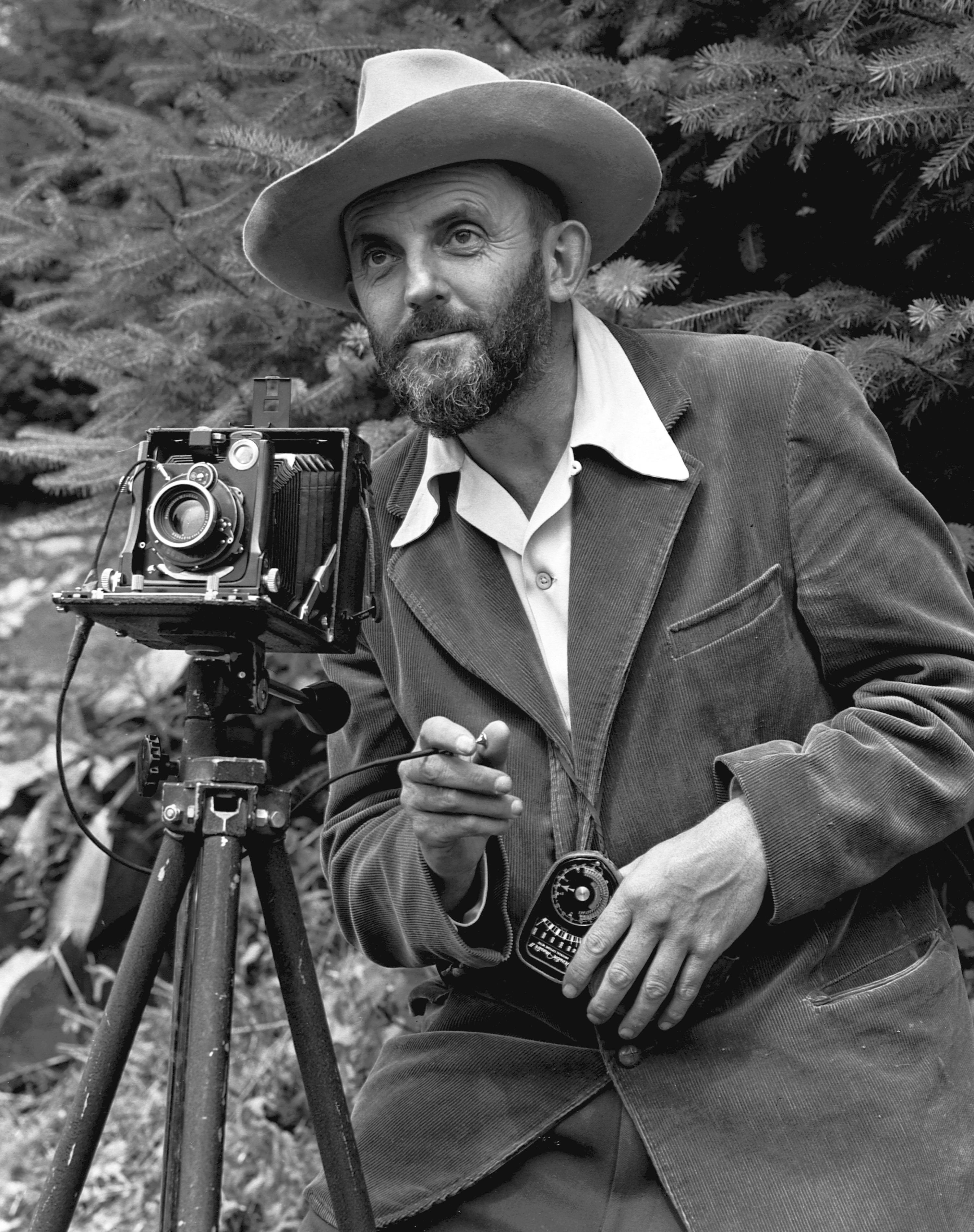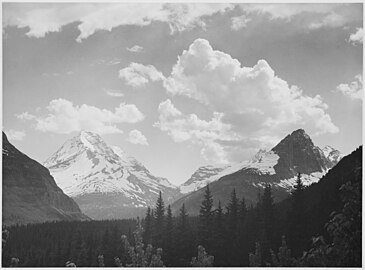
Ansel Adams
Ansel Easton Adams (February 20, 1902 – April 22, 1984) was an American landscape photographer and environmentalist known for his black-and-white images of the American West. He helped found Group f/64, an association of photographers advocating "pure" photography which favored sharp focus and the use of the full tonal range of a photograph. He and Fred Archer developed a system of image-making called the Zone System, a method of achieving a desired final print through a technical understanding of how the tonal range of an image is the result of choices made in exposure, negative development, and printing.
Ansel Adams
April 22, 1984 (aged 82)
Ashes placed on the summit of Mount Ansel Adams in California's Ansel Adams Wilderness area[1]
Photography and conservationism
Board of Directors, Sierra Club
Adams was a life-long advocate for environmental conservation, and his photographic practice was deeply entwined with this advocacy. At age 14, he was given his first camera during his first visit to Yosemite National Park. He developed his early photographic work as a member of the Sierra Club. He was later contracted with the United States Department of the Interior to make photographs of national parks. For his work and his persistent advocacy, which helped expand the National Park system, he was awarded the Presidential Medal of Freedom in 1980.
Adams was a key advisor in the founding and establishment of the photography department at the Museum of Modern Art in New York, an important landmark in securing photography's institutional legitimacy. He helped to stage that department's first photography exhibition, helped found the photography magazine Aperture, and co-founded the Center for Creative Photography at the University of Arizona.
Early life[edit]
Birth[edit]
Adams was born in the Fillmore District of San Francisco, the only child of Charles Hitchcock Adams and Olive Bray. He was named after his uncle, Ansel Easton. His mother's family came from Baltimore, where his maternal grandfather had a successful freight-hauling business but lost his wealth investing in failed mining and real estate ventures in Nevada.[2] The Adams family came from New England, having migrated from the north of Ireland during the early 19th century. His paternal grandfather founded a very prosperous lumber business that his father later managed. Later in life, Adams condemned the industry his grandfather worked in for cutting down many of the redwood forests.[3]
Early childhood[edit]
One of Adams's earliest memories was watching the smoke from the fires caused by the 1906 San Francisco earthquake. Then four years old, Adams was uninjured in the initial shaking but was tossed face-first into a garden wall during an aftershock three hours later, breaking and scarring his nose. A doctor recommended that his nose be reset once he reached maturity, but it remained crooked and necessitated mouth breathing for the rest of his life.[4][5]
In 1907, his family moved 2 miles (3 km) west to a new home near the Seacliff neighborhood of San Francisco, just south of the Presidio Army Base.[6] The home had a "splendid view" of the Golden Gate and the Marin Headlands.[7]
Adams was a hyperactive child and prone to frequent sickness and hypochondria. He had few friends, but his family home and surroundings on the heights facing the Golden Gate provided ample childhood activities. He had little patience for games or sports; but he enjoyed the beauty of nature from an early age, collecting bugs and exploring Lobos Creek all the way to Baker Beach and the sea cliffs leading to Lands End,[7][8] "San Francisco's wildest and rockiest coast, a place strewn with shipwrecks and rife with landslides."[9]
Early education[edit]
Adams's father had a three-inch telescope, and they enthusiastically shared the hobby of astronomy, visiting the Lick Observatory on Mount Hamilton together. His father later served as the paid secretary-treasurer of the Astronomical Society of the Pacific, from 1925 to 1950.[10]
Charles Adams's business suffered large financial losses after the death of his father in the aftermath of the Panic of 1907. Some of the loss was due to his uncle Ansel Easton and Cedric Wright's father George secretly having sold their shares of the company, "knowingly providing the controlling interest" to the Hawaiian Sugar Trust for a large amount of money.[11] By 1912, the family's standard of living had dropped sharply.[12]
Adams was dismissed from several private schools for being restless and inattentive, so when he was 12, his father decided to remove him from school. For the next two years he was educated by private tutors, his aunt Mary, and his father. Mary was a devotee of Robert G. Ingersoll, a 19th-century agnostic and women's suffrage advocate, so Ingersoll's teachings were important to his upbringing.[13] During the Panama–Pacific International Exposition in 1915, his father insisted that he spend part of each day studying the exhibits as part of his education.[14] He eventually resumed, and completed, his formal education by attending the Mrs. Kate M. Wilkins Private School, graduating from the eighth grade on June 8, 1917. During his later years, he displayed his diploma in the guest bathroom of his home.[15]
His father raised him to follow the ideas of Ralph Waldo Emerson: to live a modest, moral life guided by a social responsibility to man and nature.[13] Adams had a loving relationship with his father, but he had a distant relationship with his mother, who did not approve of his interest in photography.[16] The day after her death in 1950, Ansel had a dispute with the undertaker when choosing the casket in which to bury her. He chose the cheapest in the room, a $260 coffin that seemed the least he could purchase without doing the job himself. The undertaker remarked, "Have you no respect for the dead?" Adams replied, "One more crack like that and I will take Mama elsewhere."[17]
Photographs[edit]
Color images[edit]
Adams was known mostly for his boldly printed, large-format black-and-white images, but he also worked extensively with color.[170] However, he preferred black-and-white photography, which he believed could be manipulated to produce a wide range of bold, expressive tones, and he felt constricted by the rigidity of the color process.[171] Most of his color work was done on assignments, and he did not consider his color work to be important or expressive, even explicitly forbidding any posthumous exploitation of his color work.
Most of Adams' best known images were taken with 8x10 and 4x5 view cameras. He also used a variety of other negative formats, from 35mm and medium format roll film through less common formats such as Polaroid type 55 and 7x17 panoramic cameras.
The 1958 documentary Ansel Adams, Photographer, narrated by Beaumont Newhall, gives an overview of Adams's toolkit at the time, with some examples of his camera outfits including:
Adams mounted a platform on the roof of his car to allow him to take images with the view cameras from an elevated point of view.[179]












